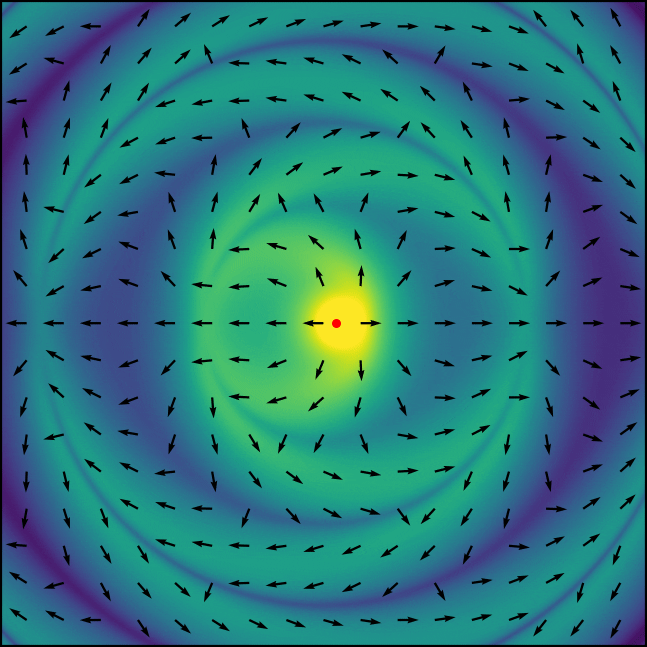PyCharge
PyCharge is an open-source computational electrodynamics Python simulator that can calculate the electromagnetic fields and potentials generated by moving point charges and can self-consistently simulate dipoles modeled as Lorentz oscillators.

PyCharge was designed to be accessible for a wide range of use cases: it can be used as a pedagogical tool for undergraduate and graduate-level EM theory courses to provide an intuitive understanding of the EM waves generated by moving point charges, and can also be used by researchers in the field of nano-optics to investigate the complex interactions of light in nanoscale environments.
Key Features
- Calculate the relativistically-correct electromagnetic fields and potentials generated by moving point charge sources in a system at specified grid points in space and time. The moving point charges can have custom trajectories.
- Self-consistent simulatations of dipoles modeled as Lorentz oscillators which are driven by the electric field in the system. PyCharge dynamically determines the dipole moment at each time step.
- Expected coupling between dipoles predicted by QED theory is captured in the simulations, and the modified radiative properties of the dipoles (radiative decay rate and frequency shift) can be extracted using the dipole's energy at each time step.
- Moving dipoles can be modelled by specifying the dipole's origin position as a function of time.
- Parallelized version of the dipole simulation method using mpi4py to enable the parallel execution of computationally demanding simulations on high performance computing environments to significantly improve run time.
Our computational physics paper introducing the PyCharge package is available on TODO and includes an extensive review of the rich physics that govern the coupled dipole simulations.
Documentation
See the manual hosted at pycharge.readthedocs.io for the latest documentation.
Installation
PyCharge and its dependencies can be installed using pip:
pip install pycharge
To install in development mode, clone the GitHub repository and install with pip using the editable option:
git clone https://github.com/MatthewFilipovich/pycharge
pip install -e ./pycharge
Usage
An overview of the classes and methods implemented in the PyCharge package is shown in the figure below:

The electromagnetic fields and potentials generated by moving point charges can be calculated using PyCharge with only a few lines of code. The following script calculates the electric field components and scalar potential along a spatial grid in the x-y plane generated by two stationary charges:
import pycharge as pc
from numpy import linspace, meshgrid
from scipy.constants import e
sources = (pc.StationaryCharge((10e-9, 0, 0), e),
pc.StationaryCharge((-10e-9, 0, 0), -e))
simulation = pc.Simulation(sources)
coord = linspace(-50e-9, 50e-9, 1001)
x, y, z = meshgrid(coord, coord, 0, indexing='ij')
Ex, Ey, Ez = simulation.calculate_E(0, x, y, z)
V = simulation.calculate_V(0, x, y, z)
Two dipoles separated by 80 nm along the x-axis are simulated over 40,000 timesteps in the script below:
import pycharge as pc
from numpy import pi
timesteps = 40000
dt = 1e-18
omega_0 = 100e12*2*pi
origins = ((0, 0, 0), (80e-9, 0, 0))
init_d = (0, 1e-9, 0)
sources = (pc.Dipole(omega_0, origins[0], init_d),
pc.Dipole(omega_0, origins[1], init_d))
simulation = pc.Simulation(sources)
simulation.run(timesteps, dt, 's_dipoles.dat')
For more examples and usage, please refer to the documentation.





